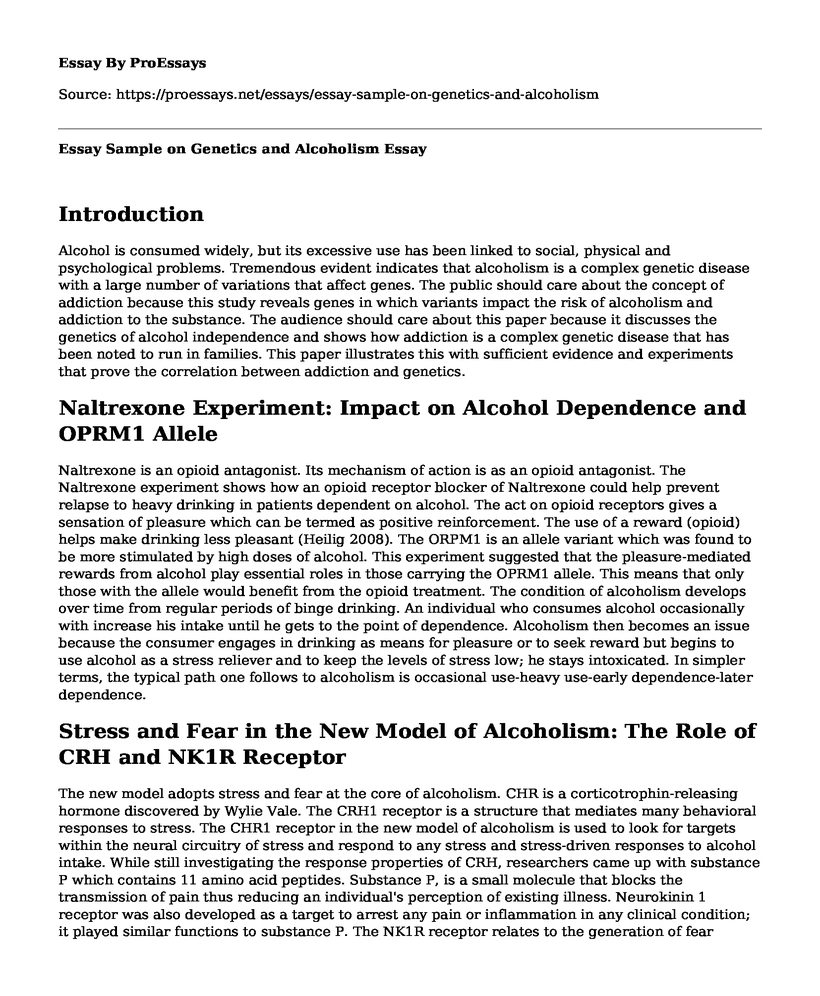Introduction
Alcohol is consumed widely, but its excessive use has been linked to social, physical and psychological problems. Tremendous evident indicates that alcoholism is a complex genetic disease with a large number of variations that affect genes. The public should care about the concept of addiction because this study reveals genes in which variants impact the risk of alcoholism and addiction to the substance. The audience should care about this paper because it discusses the genetics of alcohol independence and shows how addiction is a complex genetic disease that has been noted to run in families. This paper illustrates this with sufficient evidence and experiments that prove the correlation between addiction and genetics.
Naltrexone Experiment: Impact on Alcohol Dependence and OPRM1 Allele
Naltrexone is an opioid antagonist. Its mechanism of action is as an opioid antagonist. The Naltrexone experiment shows how an opioid receptor blocker of Naltrexone could help prevent relapse to heavy drinking in patients dependent on alcohol. The act on opioid receptors gives a sensation of pleasure which can be termed as positive reinforcement. The use of a reward (opioid) helps make drinking less pleasant (Heilig 2008). The ORPM1 is an allele variant which was found to be more stimulated by high doses of alcohol. This experiment suggested that the pleasure-mediated rewards from alcohol play essential roles in those carrying the OPRM1 allele. This means that only those with the allele would benefit from the opioid treatment. The condition of alcoholism develops over time from regular periods of binge drinking. An individual who consumes alcohol occasionally with increase his intake until he gets to the point of dependence. Alcoholism then becomes an issue because the consumer engages in drinking as means for pleasure or to seek reward but begins to use alcohol as a stress reliever and to keep the levels of stress low; he stays intoxicated. In simpler terms, the typical path one follows to alcoholism is occasional use-heavy use-early dependence-later dependence.
Stress and Fear in the New Model of Alcoholism: The Role of CRH and NK1R Receptor
The new model adopts stress and fear at the core of alcoholism. CHR is a corticotrophin-releasing hormone discovered by Wylie Vale. The CRH1 receptor is a structure that mediates many behavioral responses to stress. The CHR1 receptor in the new model of alcoholism is used to look for targets within the neural circuitry of stress and respond to any stress and stress-driven responses to alcohol intake. While still investigating the response properties of CRH, researchers came up with substance P which contains 11 amino acid peptides. Substance P, is a small molecule that blocks the transmission of pain thus reducing an individual's perception of existing illness. Neurokinin 1 receptor was also developed as a target to arrest any pain or inflammation in any clinical condition; it played similar functions to substance P. The NK1R receptor relates to the generation of fear because it performed related duties of concern such as suppressed craving and suppression of stress (Heilig 2008). According to the author, the NK1R receptor increases as the alcoholism condition develops because the stronger the need for alcohol, the stronger the NK1R's functioning as a block to suppress alcohol cravings.
A placebo is a procedure applied medically to benefit a patient psychologically rather than physiologically (Moussas et al 2009). The blocked NK1R receptor experiment is significantly used to benefit alcoholics psychologically was significant because the fMRI machine helped visualize neuron activities to particular stimuli. This procedure is beneficial because it revealed negative and positive emotions that would help conclude on the matter of genetics and alcoholism. With the NK1R blocker, patients treated psychologically were found to have all but absent brain responses to pleasant pictures meaning the receptor helped activate brain circuitry. All these experiments have proven that alcoholics are more sensitive to stress compared to non-alcoholics. Blocking the NK1R receptor focused on brain responses of alcoholics with focus on images; this experiment helped reduce activation with negative emotions.
Conclusion
The new model of alcoholism is exceptional because it relies on anti-stress treatments and the use reward to solve the issue. Basing on the findings in this article, it appears that there is a cross-link between alcoholism, positive reinforcement and stress thus making the study reliable.
References
Heilig, M. (2008). Triggering addiction: Molecular biology teases out two distinct forms of alcoholism. The scientist magazine, 22(12), 30-35.
Moussas, G., Christodoulou, C., & Douzenis, A. (2009). A short review on the aetiology and pathophysiology of alcoholism Annals of General Psychiatry, 8 (1) DOI: 10.1186/1744-859X-8-10
Cite this page
Essay Sample on Genetics and Alcoholism. (2022, Oct 13). Retrieved from https://proessays.net/essays/essay-sample-on-genetics-and-alcoholism
If you are the original author of this essay and no longer wish to have it published on the ProEssays website, please click below to request its removal:
- The Societal Impact on Fibromyalgia Patients
- Understanding Typologies and Characteristics of Terrorism Essay
- Seneca Falls: Women's Rights Convention Essay
- Essay Example on Asthma: Airway Inflammation, Swelling, and Difficulty Breathing
- Research Paper on Substance Abuse Programs: Stigma, Weak Leadership, and Problematic Patients
- Unequal Social Structures & Racism in US: Reactions & Societal Changes - Essay Sample
- Essay Example on Depression & Anxiety: Different Conditions, Common Symptoms







